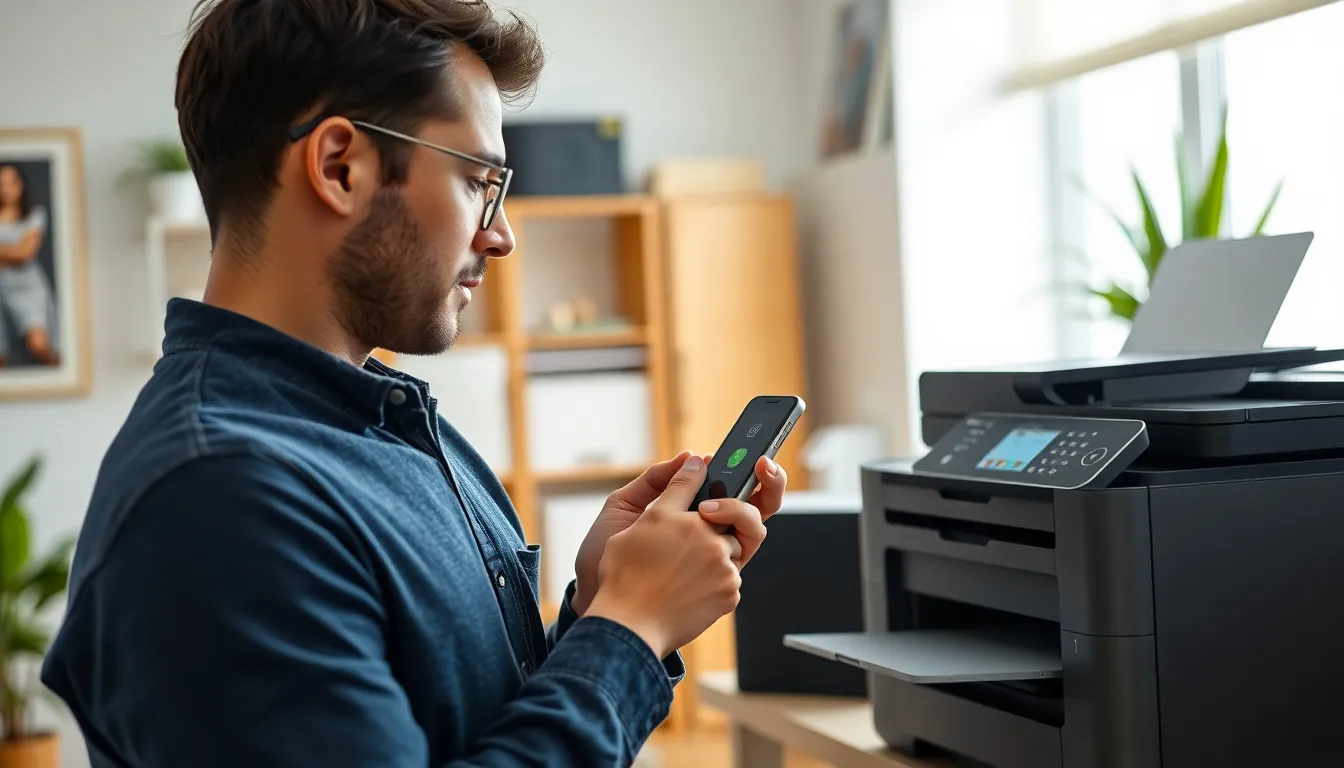In a world where smartphones are practically an extension of our hands, the quest to find a printer on an iPhone can feel like searching for a needle in a haystack. It’s like trying to locate a unicorn in a crowded city—confusing and slightly magical. But fear not! With just a few taps, that elusive printer is within reach, ready to transform your digital masterpieces into tangible works of art.
Table of Contents
ToggleUnderstanding Printer Compatibility
Finding the right printer for an iPhone requires understanding the compatibility options available. Familiarity with AirPrint can simplify the printing process significantly.
AirPrint-Compatible Printers
AirPrint-compatible printers allow seamless printing without additional drivers or software. These printers connect directly to the Wi-Fi network, making them easier to find on an iPhone. Brands like HP, Canon, and Epson offer a wide range of AirPrint-enabled models. Users simply select the printer and start printing from any application that supports it. Check the printer’s specifications to confirm AirPrint compatibility. When you choose an AirPrint printer, the chances of encountering connectivity issues decrease.
Non-AirPrint Printer Solutions
Non-AirPrint printers also provide printing capabilities for iPhone users through alternative solutions. Many manufacturers offer mobile printing apps that facilitate connection and printing. For example, Brother and Lexmark provide dedicated applications designed to bridge the gap. Often, these apps enhance functionality by enabling additional features such as scanning and faxing. Users might need to connect their iPhone and printer via Bluetooth or Wi-Fi Direct. Using these applications ensures that non-AirPrint printers remain practical options for printing documents and photos from an iPhone.
Setting Up Your iPhone for Printing

Setting up your iPhone for printing involves a few essential steps. Users must ensure their devices are properly connected to the printer.
Wi-Fi Connection Requirements
Wi-Fi connectivity is crucial for printing from an iPhone. Only AirPrint-compatible printers can connect directly to a Wi-Fi network without additional software. Ensure that both the iPhone and the printer connect to the same Wi-Fi network. Checking the Wi-Fi settings on the iPhone can help confirm this. If using a non-AirPrint printer, check that the manufacturer offers a mobile app. This app must also be installed on the iPhone to enable successful printing.
Checking Printer Status and Connectivity
Checking the printer’s status helps avoid printing issues. Users can power on the printer and look for indicator lights to verify its readiness. If the printer has a display, navigate to its settings to check the Wi-Fi connection. An error status or disconnected message may require troubleshooting steps, such as resetting the printer’s connection to the Wi-Fi network. On the iPhone, opening the printing options will show available printers. Refreshing the printer list may reveal newly connected devices.
Locating a Printer on Your iPhone
Finding a printer on your iPhone can be straightforward. Users can easily access available printers through various methods.
Using the Print Option in Apps
Apps typically include a print option in their share menu. While viewing a document or photo, tapping the share icon reveals a list of available actions. Users then scroll to select “Print.” A new screen will show all nearby AirPrint-compatible printers. Selecting the printer opens additional settings, allowing users to adjust options like the number of copies or color preferences. After confirming the settings, hitting “Print” sends the job directly to the selected printer.
Accessing Printer through Settings
Another way to locate a printer involves navigating the iPhone’s settings. Opening the “Settings” app is the first step. From there, users scroll to “Wi-Fi” to ensure the iPhone is connected to the same network as the printer. Once connected, users can look for the “Printers” section in specific app settings or directly under “Bluetooth.” Identifying printers in this area may streamline the connection process. Ensuring the printer is ready for use can prevent unnecessary frustrations.
Troubleshooting Issues
Encountering difficulties while trying to print from an iPhone can be frustrating. Several common problems often hinder connectivity and print quality.
Common Connectivity Problems
Connectivity issues frequently arise due to network settings or printer compatibility. Both devices must share the same Wi-Fi network to establish a connection. If the printer is not showing on the iPhone, checking the printer’s Wi-Fi status or signal strength may help. In many instances, restarting the printer and the iPhone resolves minor connection errors. Users should also ensure that firmware is up to date on the printer, as outdated software can lead to compatibility problems. Familiarity with specific settings in the mobile printing app can streamline connectivity.
Addressing Print Quality Issues
Print quality problems manifest in various forms, from smudged text to faded colors. Users can start by examining the print settings on the iPhone to ensure they meet the desired output quality. Cleaning the print head or using the printer’s built-in maintenance features can significantly enhance clarity. Users often overlook checking ink or toner levels, so verifying these can prevent poor print results. It’s advisable to use the appropriate paper type as well, as certain printers perform better with specific paper options. Addressing these factors typically improves print outcomes considerably.
Finding a printer on an iPhone doesn’t have to be a daunting task. With the right steps and understanding of printer compatibility users can easily print their documents and photos. AirPrint-compatible printers offer a seamless experience while non-AirPrint solutions still provide effective alternatives.
By ensuring both the iPhone and printer are connected to the same Wi-Fi network users can quickly access available printers. Troubleshooting common issues can further enhance the printing experience. With these tips in mind anyone can transform their digital creations into tangible prints effortlessly.




